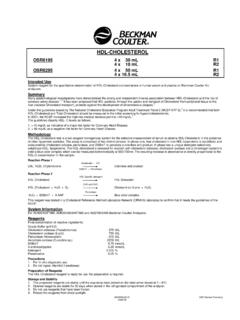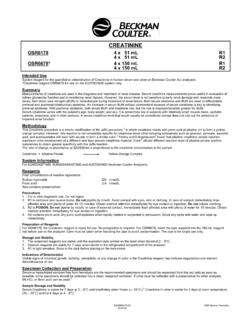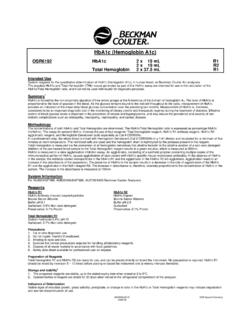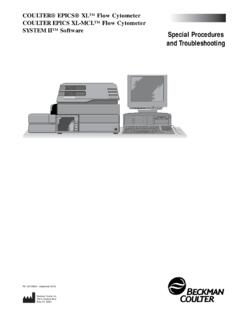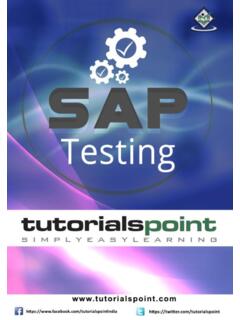Transcription of LS 13 320 Laser Diffraction Particle Size Analyzer
1 PN B05577 ABOctober 2011 Instruction For UseLS 13 320 Laser Diffraction Particle Size AnalyzerBeckman Coulter, S. Kraemer , CA 92821 LS 13 320 Laser Diffraction Particle Size AnalyzerInstructions For UsePN B05577AB (October 2011) 2011 beckman Coulter, us on the World Wide Web at: B05577 ABiiiRevision HistoryFirst Revision, B05577AB, October 2011 Changes: Updated corporate address Revised Figure Certification Label (Instrument Back Cover) Other minor edits and deletions Revision page added Added the beckman Coulter, Inc. Customer End User License Agreement Trademarks page addedInitial Issue, B05577AA, 2009 Document placed into the BCI structured FrameMaker formatPN B05577 ABivRevision History vSafetySymbols Used in this ManualWARNINGW arning - Indicates a situation or procedure that if ignored can result in personal - Indicates a situation or procedure that if ignored may result in damage to the Indicates a situation or procedure that if ignored can result in erroneous test (Help note) contains hints and useful information to help optimize results quality and ease of The optical bench and sample modules are referred to as the Analytical Module.
2 The PC, keyboard, monitor and printer, etc., are all referred to collectively as the computer . Bold type letters like this Enter Sample ID represent menu or button text appearing on the screen of the computer that can be selected with the mouse or by keystrokes. means click the mouse button. Unless the mouse has been inverted for left-handed users, this will be the left mouse button. The symbol points you to where additional information on a subject can be Precautions Laser PrecautionsThe LS 13 320 contains a 5 mW diode Laser . The instrument therefore may pose certain hazards associated with low-power lasers if misused.
3 You should be aware of these possible hazards as described in the next paragraph. Additionally, misuse of diluents for sample dispersion can also create hazardous Safety PrecautionsIMPORTANTD iode Laser power of up to 5 mW at 750 nm or 780 nm could be accessible in the interior if the safety interlocks are comply with Federal Regulations (21 CFR Subchapter J) as administered by the Food and Drug Administration's (FDA) Center for Devices and Radiological Health (CDRH), defeatable microswitches are located on the right and left of the door panel. Because the system contains a Laser , it should be isolated from non- Laser instruments. Users are advised to keep a copy of ANSI standard , SAFE USE OF LASERS, near the instrument for ready reference.
4 Copies are available from:American National Standards Institute1430 BroadwayNew York, NY 10018 General Laser PrecautionsIMPORTANTThe Laser beam can cause eye damage if viewed either directly or indirectly from reflective surfaces (such as a mirror or shiny metal surface). Avoid direct exposure to beam. Do not view directly or with optical Laser is a unique light source that exhibits characteristics different from conventional light sources. The safe use of any Laser depends upon familiarity with the instrument and the properties of coherent, intense beams of light. The beam can cause eye damage. The beam might cause damage if viewed indirectly from reflective surfaces such as a mirror or shiny metal of controls or adjustments or performance of procedures other than those specified herein may result in hazardous radiation these precautions: Advise all those using the instrument of these precautions.
5 Limit access to the instrument to those trained in the use of the equipment. Post warning signs in the area of the Laser beam to alert those present. Never look directly into the Laser light source or at scattered Laser light from any reflective Precautions Stop viewing if: you see an unusually bright spot that makes you uncomfortable (similar to looking at the sun). you get a headache (a symptom of overexposure). Do not tamper with or attempt to defeat the safety interlock 13 320 Specific Precautions Never place a mirror or optical surface (other than the sample cell assembly) into the optical axis of the system. Do not place your hands in the pathway of the door as it closes.
6 Do not place your hands or any object inside the optical bench as the module is HazardsIn the design and manufacture of the beckman COULTER LS 13 320, beckman Coulter Inc., Particle Characterization Group, has complied with the requirements governing the use and application of a Laser as stipulated in regulatory documents issued by the Department of Health and Human Services and the Center for Devices and Radiological Health (CDRH). In compliance with these regulatory documents, every measure has been taken to ensure the health and safety of users and laboratory personnel from the possible dangers of Laser use. CDRH-required labels are placed near or on those covers that, when removed, might expose Laser radiation.
7 See figure for the warning labels and their Precautions Figure Warning labels - Instrument Front Cover And Laser Cover ixSafetyLaser Precautions Figure Certification Label (Instrument Back Cover)xSafetyOther Precautions Other PrecautionsWarningsMechanical Do not place fingers inside bench as automatic sliding door closes. Do not place fingers inside bench as module docks into bench. Do not interfere with or attempt to disable the interlocks incorporated in the left and right High voltages are present inside the instrument.
8 Always disconnect the instrument from the main power supply before removing any cover. The instrument must be grounded Do not use any diluents that are not compatible with the specific wetted surface of the sample module. Consult beckman Coulter or its local representative before using any chemicals not listed in this manual. Proper handling procedures for diluents and reagents used in Particle analysis should be adhered to at all times. Consult appropriate safety manuals and Material Safety Data Sheets for all samples, diluents and reagents used. Care should be taken when mixing or exchanging diluents. Reactions can occur between incompatible solvents that may be violent. Flammable solutions should be prepared for use in an appropriate environment and brought to the instrument only when required for non-aqueous solutions are flammable.
9 Where possible choose less flammable Take care disconnecting diluent lines. Open-ended tubing may allow liquid to spill out of the vessel. Never place containers of liquids on top of the LS 13 320. Repair of instruments damaged or affected by spilled liquids will not be covered by any Precautions Warming upAs with all sensitive electronic instruments, the LS 13 320 components achieve best performance once they have reached a steady working temperature. This may typically take 15 minutes from power of Error Sample dispersion Air bubbles Misalignment Incorrect obscuration External mechanical vibration, if present, may cause misalignment of the Laser . (Automatic alignment should be performed more often.)
10 Electrical interference. (Use of an uninterruptible power supply (UPS) is recommended.) Sudden changes in temperature can cause misalignment as well as changes to the measured electrical Precautions xiiiContentsCHAPTER 1:Theory,1-1 Theoretical Background,1-1 Light Scattering,1-1 Mie Theory, Fraunhofer Theory,1-3 PIDS, Particle Non-Sphericity & Light Scattering,1-4 PIDS Sizing,1-5 Components,1-5 Functions,1-5 Description,1-6 CHAPTER 2:Installation,2-1 Installation Requirements,2-1 Environment,2-1 Power Requirements,2-2 Temperature and Humidity Requirements,2-2 Sample Modules Specific Requirements,2-3 Hardware Connections,2-3 Software Installation,2-4 Installing and Starting the Software,2-4 Configuring Software Parameters,2-4 Instrument Verification,2-5 Post-Installation Verification,2-5 Daily Verification,2-5 Getting Started,2-6 Starting the Instrument and its Control Program,2-6 Selecting a Module,2-8 Making Measurements,2-10 Measuring Offsets,2-10 Alignment,2-10 Measure Background,2-10 Measure Loading,2-10xivContents Running a Control,2-11 Running a Sample,2-16 Reference Background,2-17 CHAPTER 3.
